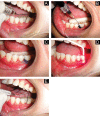Effect of Antimicrobial Photodynamic Therapy as an Adjunct to Nonsurgical Treatment of Deep Periodontal Pockets: A Clinical Study
- PMID: 28491256
- PMCID: PMC5415498
- DOI: 10.15171/jlms.2016.39
Effect of Antimicrobial Photodynamic Therapy as an Adjunct to Nonsurgical Treatment of Deep Periodontal Pockets: A Clinical Study
Abstract
Introduction: Deep periodontal pockets pose a great challenge for nonsurgical periodontal treatment. Scaling and root planing (SRP) alone may not suffice in cases where surgical therapy cannot be undertaken. Various recent studies have suggested the use of antimicrobial Photodynamic Therapy (aPDT) for the management of periodontal infections. The aim of this study was to evaluate the effects of using aPDT along with SRP, compared to SRP alone for the management of deep periodontal pockets. Methods: Thirty patients with chronic periodontitis, who met the criteria of having periodontal pockets with depth ≥ 6 mm and bleeding on probing (BOP) in at least 2 different quadrants were included. After SRP, one quadrant was randomly selected for aPDT (test), while another served as control. Clinical parameters i.e. plaque index (PI), modified sulcular bleeding index (mSBI), probing depth (PD) and clinical attachment level (CAL) were measured at baseline, 1 month and 3 months post-treatment intervals. Results: All clinical parameters significantly improved in both groups after 1 and 3 months. At 1-month interval, inter-group difference in mean change was statistically significant (P < 0.05) in terms of mSBI (0.85 ± 0.41in test vs 0.54 ± 0.47 in control group) and PD (1.77±0.86 in test vs 1.3 ± 0.95 in control group). At 3 months interval, no statistically significant difference was observed between test and control groups except in terms of mSBI (0.97 ± 0.45 in test vs 0.73 ± 0.42 in control group). Conclusion: aPDT appears to play an additional role in reduction of gingival inflammation when used along with nonsurgical mechanical debridement of deep periodontal pockets.
Keywords: Antimicrobial therapy; Diode laser; Periodontal pocket; Periodontitis; Photodynamic therapy.
Similar articles
-
Antimicrobial photodynamic therapy (aPDT) with curcumin and LED, as an enhancement to scaling and root planing in the treatment of residual pockets in diabetic patients: A randomized and controlled split-mouth clinical trial.Photodiagnosis Photodyn Ther. 2019 Sep;27:388-395. doi: 10.1016/j.pdpdt.2019.07.005. Epub 2019 Jul 10. Photodiagnosis Photodyn Ther. 2019. PMID: 31301434 Clinical Trial.
-
Transgingival photodynamic therapy (tg-aPDT) adjunctive to subgingival mechanical instrumentation in supportive periodontal therapy. A randomized controlled clinical study.Photodiagnosis Photodyn Ther. 2020 Dec;32:101971. doi: 10.1016/j.pdpdt.2020.101971. Epub 2020 Aug 21. Photodiagnosis Photodyn Ther. 2020. PMID: 32835882 Clinical Trial.
-
The application of antimicrobial photodynamic therapy (aPDT, 670 nm) and diode laser (940 nm) as adjunctive approach in the conventional cause-related treatment of chronic periodontal disease: a randomized controlled split-mouth clinical trial.Clin Oral Investig. 2020 May;24(5):1821-1827. doi: 10.1007/s00784-019-03045-1. Epub 2019 Aug 13. Clin Oral Investig. 2020. PMID: 31410672 Clinical Trial.
-
How effective is adjunctive antimicrobial photodynamic therapy in treating deep periodontal pockets in periodontal disease? A systematic review.J Investig Clin Dent. 2018 Nov;9(4):e12345. doi: 10.1111/jicd.12345. Epub 2018 Jun 4. J Investig Clin Dent. 2018. PMID: 29863310
-
Efficacy of Antimicrobial Photodynamic Therapy for Treating Moderate to Deep Periodontal Pockets in Individuals with Type 2 Diabetes Mellitus: A Systematic Review and Meta-Analysis.Dent J (Basel). 2025 Jan 2;13(1):21. doi: 10.3390/dj13010021. Dent J (Basel). 2025. PMID: 39851597 Free PMC article. Review.
Cited by
-
Effectiveness of Antimicrobial Photodynamic Therapy in the Treatment of Periodontitis: A Systematic Review and Meta-Analysis of In Vivo Human Randomized Controlled Clinical Trials.Pharmaceutics. 2021 Jun 4;13(6):836. doi: 10.3390/pharmaceutics13060836. Pharmaceutics. 2021. PMID: 34200078 Free PMC article. Review.
-
Effect of Er:YAG laser combined with ethylenediamine tetra acetic acid on three-walled periodontal intrabony defects adjacent to implant sites.Hua Xi Kou Qiang Yi Xue Za Zhi. 2021 Dec 1;39(6):718-723. doi: 10.7518/hxkq.2021.06.015. Hua Xi Kou Qiang Yi Xue Za Zhi. 2021. PMID: 34859634 Free PMC article. Chinese, English.
-
Nanocarrier-based Drug Delivery Systems to Enhance Antimicrobial Photodynamic Therapy in Dental Applications: A Review.AAPS PharmSciTech. 2025 Jun 3;26(5):160. doi: 10.1208/s12249-025-03155-y. AAPS PharmSciTech. 2025. PMID: 40461912 Review.
-
Effect of Antimicrobial Photodynamic Therapy Using Indocyanine Green Doped with Chitosan Nanoparticles on Biofilm Formation-Related Gene Expression of Aggregatibacter actinomycetemcomitans.Front Dent. 2019 May-Jun;16(3):187-193. doi: 10.18502/fid.v16i3.1590. Epub 2019 Jun 29. Front Dent. 2019. PMID: 31858084 Free PMC article.
-
Effect of one and two sessions of antimicrobial photodynamic therapy on clinical and microbial outcomes of non-surgical management of chronic periodontitis: A clinical study.J Adv Periodontol Implant Dent. 2019 Dec 18;11(2):85-93. doi: 10.15171/japid.2019.014. eCollection 2019. J Adv Periodontol Implant Dent. 2019. PMID: 35919483 Free PMC article.
References
-
- Al-Zahrani MS, Obadah NA. Photodynamic therapy as an adjunctive to scaling and root planing in treatment of chronic periodontitis in smokers. Saudi Med J. 2011;32:1183–1188. - PubMed
LinkOut - more resources
Full Text Sources
Other Literature Sources
Research Materials
Miscellaneous

